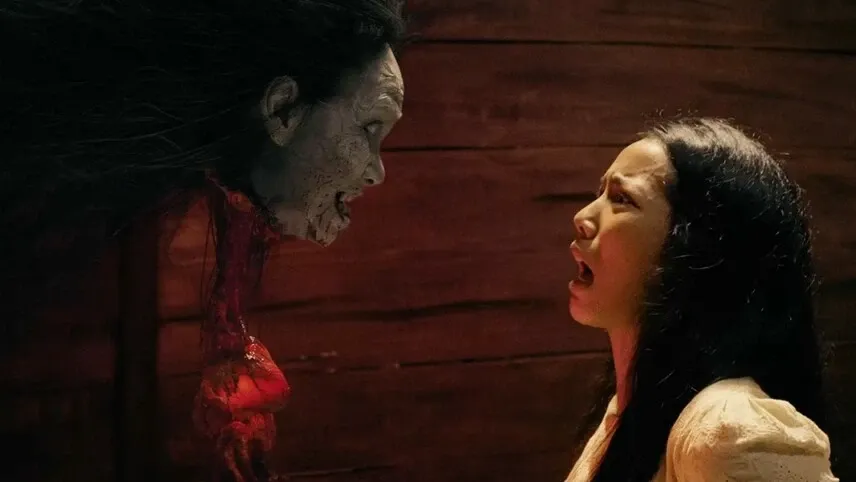Kuyang
Original Title: Kuyang
Year: 2024
Director: Yongki Ongestu
Soundtrack: [Composer’s Name]
Screenplay: [Screenwriter’s Name]
Cast:
- Rangga Azof as Bimo
- Ayu Lestari as Sriatun
- Citra Naya as Mardiyah
- Denny Sumargo as Rachmat
- Joko Anwar as Pak Udin

Introduction
In 2024, Indonesian director Yongki Ongestu presented Kuyang, a horror film that delves into local legends and superstitions with a fresh and unsettling perspective. Set in a remote village on the island of Borneo, the film blends Indonesian folklore with a gripping narrative, offering a fascinating and terrifying glimpse into the culture and beliefs of the region. This review takes an in-depth look at the film’s plot, characters, themes, and technical aspects.
Plot
The story of Kuyang revolves around Bimo, a civil service candidate assigned to a remote village on the island of Borneo. Bimo is accompanied by his pregnant wife, Sriatun. From the moment they arrive, the village is shaken by a series of strange and unsettling events.
The village is desolate, lacking electricity, and recently devastated by a flood that has significantly reduced the number of students at the local school. Bimo and Sriatun face the challenge of teaching in an almost empty school while trying to adapt to life in this remote and primitively isolated corner of the world.
The plot intensifies with the introduction of two key figures in the village: one who seeks to gain powers to become a demon and another who tries to protect the village. The conflict between these two forces becomes central to the narrative, with the supernatural threat growing as Bimo and Sriatun try to uncover what is really happening.
The horror element focuses on the darkness surrounding local legends and the malevolent forces affecting the village. As Bimo and Sriatun investigate the mysterious events, they discover that the village is a battleground between occult forces, and Sriatun’s safety, in particular, is threatened due to her pregnancy.
Characters and Cast
- Bimo (played by Rangga Azof): Bimo is the protagonist who, alongside his wife, faces the isolation and supernatural dangers of the village. His portrayal reflects a growing sense of terror and determination as he strives to protect his family and solve the mysteries surrounding them.
- Sriatun (played by Ayu Lestari): Sriatun, Bimo’s pregnant wife, is central to the plot. Her pregnancy adds an additional layer of vulnerability and tension to the film, as the threat of the Kuyang seems particularly drawn to her and the unborn child.
- Mardiyah (played by Citra Naya): Mardiyah is the figure attempting to protect the village from malevolent forces. Her determination and role as a protector are crucial in the fight against the evil plaguing the village.
- Rachmat (played by Denny Sumargo): Rachmat is the main antagonist, a person seeking to acquire demonic powers. His quest for power and his evil actions are central to the tension and mystery unfolding in the film.
- Pak Udin (played by Joko Anwar): Pak Udin is a supporting character who helps Bimo and Sriatun understand the local legends and supernatural threats. His knowledge of Indonesian folklore provides vital information for confronting the evil.
 Themes and Symbolism
Themes and Symbolism
Kuyang explores several significant themes through its horror narrative:
1. Folklore and Superstition: The film highlights traditional beliefs and Indonesian folklore, exploring how these superstitions affect and torment the lives of people in the village.
2. Vulnerability and Protection: Sriatun’s pregnancy symbolizes vulnerability and hope, and the film delves into the dynamics of protection and fear related to her condition.
3. Light and Shadow: The contrast between the darkness of the village and the struggle between supernatural forces reflects the battle between good and evil, and hope amidst fear.
Technical Aspects
1. Cinematography: The cinematography of Kuyang, handled by [Director of Photography’s Name], is particularly effective in capturing the isolated and oppressive atmosphere of the village. The nighttime shots and ambient lighting contribute to creating a sense of unease and isolation.
2. Sound Design: The sound effects are designed to amplify the tension and horror atmosphere of the film. The use of ambient sounds and unsettling noises enhances the immersive experience, accentuating moments of fear and suspense.
3. Special Effects and Makeup: The special effects used to depict demonic and supernatural manifestations are well-executed and contribute to the film’s eerie appearance. The makeup and practical effects are effectively used to create visually striking and disturbing representations of malevolent entities.
 Reception and Impact
Reception and Impact
Kuyang has received acclaim for its ability to blend elements of traditional folklore with a modern horror narrative. Critics have praised the film’s ability to create an intense atmosphere and its unique approach to the horror genre. The film has attracted attention at horror film festivals and among audiences interested in supernatural stories and cultural legends.
Conclusion
Kuyang (2024) by Yongki Ongestu is a horror film that successfully merges traditional folklore with a compelling and contemporary narrative. With an intriguing plot, well-developed characters, and a strong atmosphere, the film offers an authentic and engaging horror experience. For those who enjoy horror that explores local myths and superstitions, Kuyang represents a captivating and chilling vision of the genre.
 Subscribe to our channel YouTube
Subscribe to our channel YouTube






